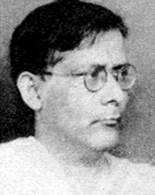Raychaudhuri, Hemchandra
Raychaudhuri, Hemchandra (1892-1957) historian. Hemchandra Raychaudhuri was born on 8 April 1892 in the village of Ponabalia in the former Bakerganj district, Bangladesh. Son of Manoranjan Raychaudhury, zamindar of Ponabalia, and Tarangini Devi, Hemchandra got his early education at the Brajamohan Institution at Barisal. His immense academic promise first became evident when he passed the Entrance Examination of the University of Calcutta (1907), having stood first among the candidates from the-then province of East Bengal and Assam. He came to Calcutta for pursuing higher education. He passed the Intermediate Arts Examination from the General Assembly's Institution (present Scottish Church College). He graduated from the Presidency College in 1911 with Honours in History having secured the first position among all Honours graduates of the University of Calcutta and was awarded the prestigious Eshan Scholarship. Two years later (1913) he passed MA Examination in History and obtained a First Class. His performance in the MA examination earned him the Griffith Prize of the University of Calcutta (1917). This was followed by his preparation of a dissertation for PhD degree of the University of Calcutta to which he was admitted in 1921.
The PhD thesis, published by the University of Calcutta in 1923, came out under the title Political History of Ancient India and earned for Raychaudhuri a distinguished place in Indian historiography. The stupendous success of this book and the lasting influence it exerted on scholars of future generations is best evident from the fact that this book ran into eight editions, six during the lifetime of its author and two more since his death.

His prime aim was to present a reliable narrative of political developments for the period from the accession of Parikshit to the rise of the Haryanka dynasty of Magadha in the 6th century BC and then a connected account of political history from the 6th century BC to the 6th century AD, which marked the end of the mighty Gupta empire in north India. He ably demonstrated by his astonishing command over diverse types of literary traditions that a reliable political narrative of the post-Indian war period could be presented. This was in sharp contrast to a widely read text book, Early History of India by Vincent Smith, who virtually discarded any possibility of writing the political history of India prior to Alexander's invasion, which to Smith was the sheet-anchor of Indian chronology.
In the second part of the book Raychaudhuri delved into the political history of nearly twelve hundred years on the basis of immaculate scrutiny of the scanty and scattered sources-epigraphic, literary and numismatic. His intention was however not to write a comprehensive survey of the political or dynastic history of every Indian province, but he was chiefly concerned with those kingdoms and empires whose influence transcended provincial limits and had important bearings upon the general course of political events in the Indian subcontinent. He elaborated and highlighted this theme by underlining the importance of two contrastive forces in early Indian political history: the love for local autonomy and the urge for imperial unity. In other words, he attempted to demonstrate that India experienced political integration and unification at certain stages of her ancient history. In the formulation of this perspective he appears to have been influenced by nationalist movement in India during the twenties and thirties of the twentieth century.
Apart from his magnum opus, Raychaudhuri also wrote Materials for the Study of the Early History of the Vaisnava Sect, published by the University of Calcutta (first edition 1920, second edition 1936). This continues to be one of the most authentic sourcebooks on vaisnavism in early India. No less famous is his Studies in Indian Antiquities which is a collection of his essays (first edition 1932 and second edition 1958). In this last named work he pointed out that the idea of space was no less important than that of time in historical studies. This was driven home by his in-depth studies of the historical geography of India and cosmographical ideas in early India, often on the basis of Puranic texts. Ever critical in the use of his sources, Raychaudhuri rejected many fanciful geographical ideas of the Puranic texts. Among his other contributions mention must be made of his chapter in the History of Bengal, vol I, (Dhaka University, 1942) edited by RC Majumdar and also his chapter in the Early History of the Deccan edited by G Yazdani. He co-authored the widely read An Advanced History of India along with RC Majumdar and KK Dutta.
Raychaudhuri the historian had a very distinguished teaching career too. Immediately after passing the MA examination he taught as a Lecturer in History in Bangabasi College, Calcutta (1913-14) followed by his three-year stint as a teacher in Presidency College (1914-16) and as a Lecturer in the Government College in Chittagong. Then came the most important phase of his teaching career when he joined the newly founded Department of Ancient Indian History and Culture, University of Calcutta (1917). In 1936 he was appointed to the hallowed chair, Carmichael Professor, in the same Department which he headed till his retirement in 1952. In 1928, he briefly served the University of Dhaka as the Reader and Head of the Department of History.
Universally respected for his scholarship, Raychaudhuri received many laurels. He was made a Fellow of the Asiatic Society of Bengal and in 1951 was honoured by Asiatic Society's BC Law Gold Medal. He was elected Sectional Chairman of the Indian History Congress in the Hyderabad session (1941) and subsequently the General President of the same academic body in the Nagpur session (1950). His academic activities would have undoubtedly flowered more, had he not suffered from prolonged illness to which he ultimately succumbed in 1957. The asiatic society, Calcutta, has recently honoured his memory by instituting a medal named after him. [Ranabir Chakravarti]
